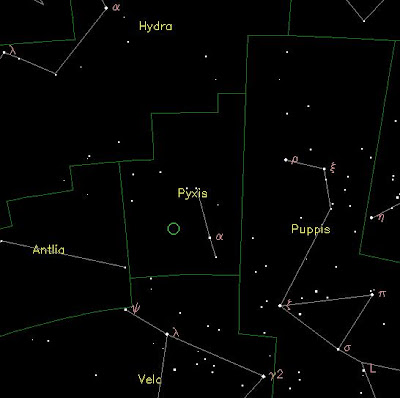
Are you ready to observe a nova event which can be caught in simple binoculars? Then open your eyes wide and locate T Pyxidis! Right now it’s showing up as just slightly fainter than magnitude 7, which means it is going to appear as an “extra star” in an otherwise rather starless portion of the constellation of Pyxis. Are you ready? Then let’s dance…
T Pyxidis is actually a binary star – one much like our own Sun with a white dwarf companion. Thanks to its diminuative, heavy-weight companion, matter from the primary star is always being drawn toward the secondary causing periodic thermonuclear explosions. Since there hasn’t been any real activity in about 45 years, astronomers believed T Pyx could possibly have began evolving into an entirely new system and activity wouldn’t occur perhaps for centuries. But they were wrong…
With a normal magnitude of 15.5, T Pyxidis would only be visible to some of the largest of amateur telescopes, but right now it can easily be spotted with average binoculars. The first finder chart seen on this page will get you in the right area and the one below will get you spot on (RA 09h 04m 41.50s Dec -32° 22′ 47.5″).

The fun part about observing T Pxidis is that it’s an object well suited for both hemispheres – one where the south is a bit more favored than the north – and all the “buzz” that goes with it. According to many sources, the white dwarf may be nearing its Chandrasekhar limit and become a Type 1a supernova when it collapses under its own weight. Says Edward Sion (et al); “The recurrent nova T Pyxidis has had 5 recorded thermonuclear explosions, more than any other recurrent nova, with an average time between nova outbursts of 19 years. However, it has been 44 years since its last nova outburst in 1966, making it long overdue for the next nova (supernova?). ”
However, don’t worry about this 3,300 light year distant stellar explosion happening any time soon. It’s estimated that kind of action may take as long as another couple of million years. “A key fact about T Pyx is that its accretion rate has been secularly declining since before the 1890 eruption, with the current rate being only 3% of its earlier rate. The decline in the observed accretion rate shows that the supersoft source is not self-sustaining, and we calculate that the accretion in T Pyx will effectively stop in upcoming decades.” say Bradley E. Schaefer (et al). “With this, T Pyx will enter a state of hibernation, lasting for an estimated 2,600,000 years, before gravitational radiation brings the system into contact again. Thus, T Pyx has an evolutionary cycle going from an ordinary CV state, to its current RN state, to a future hibernation state, and then repeating this cycle.”
But don’t you wait that long to observe it... It might be the only chance in your lifetime. For the next week or so, the Moon won’t interfere with your early evening chance to see this very cool cosmic customer!
No comments:
Post a Comment